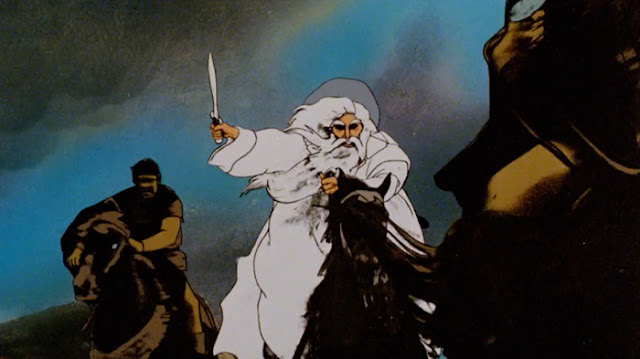PHENOMENALITY: *marvelous*
MYTHICITY: *fair*
FRYEAN MYTHOS: *adventure*
CAMPBELLIAN FUNCTION: *metaphysical, sociological*
I was tempted to validate Ralph Bakshi's LORD OF THE RINGS as having "good" mythicity just because he managed to treat Tolkien's epic fantasy with a sense of high seriousness, in contrast to the only previous adaptation of the author, Rankin-Bass's 1977 THE HOBBIT. Even the fact that Bakshi's RINGS could not adapt the whole book, and that he was never able to produce a sequel to complete the full adaptation, would not have necessarily disqualified the movie in my mythicity canon, given that I have on occasion included one or two unfinished works there.
Yet seriousness is not enough. I don't claim to have the only possible take on the deep mythopoetics of the Tolkein epic, but one theme I identified in this essay centered upon the nature of identity in human beings, animals, and supernatural creatures, and how such identity was nullified by Sauron's creation, the One Ring. I appreciate how Bakshi-- a fan of the epic since its publication in the 1950s-- exerted himself to fit in all the major incidents of the book's first two parts. But the true meaning of the Ring's threat to identity got lost in the shuffle. Bakshi reproduces with great fidelity all of the events of Frodo's misuse of the Ring at the Prancing Pony, and he even shows the horror of the customers when Frodo disappears. But there's no sense of what's going on in Frodo's head, what sudden temptation makes him distance himself from his fellow creatures.
This particular example ties in with another limitation in Bakshi's version. The novel may deal with an ensemble of heroes, but the central struggle is that of the Ring-bearer Frodo, and to a lesser extent that of his faithful retainer Samwise. Bakshi does not really "get" any of the hobbits, not even the much less complicated Merry and Pippin. From first to last they seem to be like water-carriers to the more grandiose figures of wizards and elves. I hypothesize that Bakshi was so focused upon doing justice to Tolkien's epic scale that the homey charms of the hobbits were utterly lost on him-- which is ironic for an animation director who made his bones depicting the "everyman" character of Robert Crumb's FRITZ THE CAT. As a comparable irony, I noted in my review of RETURN OF THE KING that the Rankin-Bass people seemed comfortable with the homey stuff but not with the grandeur.
The other major debit of the Bakshi Version relates to his dependence on rotoscoping. I thought he did a creditable job with all the major characters, but he renders all of the orcs and similar horrors as vague silhouettes, sometimes with fangs or red eyes superimposed. I realize that it would have cost a lot more to do even semi-individualized Spawns of Evil, but every time I saw those specters, they looked like nothing but cost-saving measures, not fearsome warriors.
Nevertheless, I like all of Bakshi's grandiose figures, though for some reason Aragorn looks like a Native American guy. Gandalf, voiced by William Squire, steals every scene he's in, and his confrontation with the Balrog in the mines of Moria is every bit as dramatic as the live-action depiction in Jackson's FELLOWSHIP. On the whole, though, Jackson manages to excel both Bakshi and Rankin-Bass in being able to balance the bucolic and the resplendent. But Bakshi provided a very enjoyable precursor to a classic adaptation.


No comments:
Post a Comment